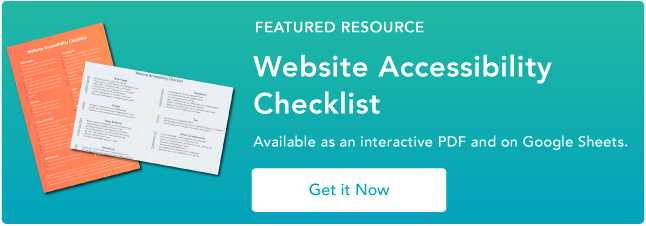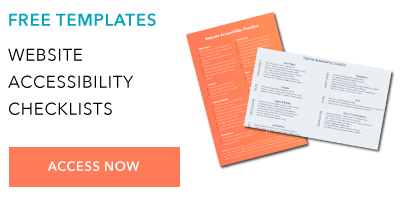Creating an easy-to-use website is essential for helping online shoppers develop a positive perception of your brand. While many companies spend hours fine-tuning design elements and taking perfect product photos, many overlook the needs of individuals with disabilities.
Website accessibilityhas become a major talking point in e-commerce, and for good reason. Individuals who are blind, deaf, or have mobility impairments shouldn't be discouraged from making purchases just because a website doesn't account for their disability.
And, by prioritizing web accessibility, e-commerce brands better serve all of their potential customers, which ultimately means better results for their bottom line.
Let's break down the importance of web accessibility, including why it should be prioritized and how it can benefit your business.
Why Should You Prioritize Web Accessibility?
Commerce is moving online.
In 2019, the U.S. Department of Commercereportedthat online retail sales topped $601 billion, a nearly 15% increase from the year before. It shouldn't come as much surprise that this coincides with many brick and mortar locations struggling to maintain foot traffic levels, and some formerly powerful retail chains going out of business entirely.
At first glance, ecommerce seems like a helpful solution for many individuals with disabilities. As commerce shifts online, it reduces the need to go to a store to make purchases — a task that requires physical assistance for many. Getting orders shipped right to the front door eases the logistical burden of shopping trips.
This potential benefit is even more pronounced for individuals who temporarily or permanently are unable to leave their homes. Regardless of whether this is for health reasons or a lack of transportation, for these people the internet becomes the primary resource for accessing information and shopping for essential products.
Unfortunately, while the potential for improved quality of life is certainly possible through the internet, it's not yet a reality for many living with disabilities.
Most websites aren't compliant with web accessibility standards.
The Web Accessibility Initiative'sWeb Content Accessibility Guidelines(WCAG) provide steps that website designers should take to account for individuals with disabilities. This covers a wide spectrum of disabilities, including those with blindness, deafness, photosensitivity, cognitive limitations, and mobility impairments.
While these guidelines are well-publicized, many websites don't have features that improve the browsing and purchasing process for disabled customers.
As an indicator of just how widespread these barriers are,researchrevealed that of the 10 million websites analyzed, 98% had non-WCAG compliant menus. These menus lacked proper NAV tags and role attributes for screen reader compatibility, or didn't allow customers to navigate the menu using their keyboard.
.png)
Other areas were nearly as problematic. 89% of popups, 83% of buttons, and 71% of forms failed to meet WCAG compliance standards. Roughly 95% of the websites that were evaluated had additional compliance issues.
For most users, a lack of keyboard navigation or improper color balance will likely be little more than a minor annoyance. But for individuals with disabilities, this could make all the difference in whether they can complete a purchase.
Customers with disabilities are a large and valuable audience.
Despite the perception that the internet is full of complaints and negative reviews, most people keep quiet about their negative experiences. Rather than submit a complaint, they just won't continue doing business with your brand.
This is also true for users with disabilities. The2019 Click-Away Pound Reportfound that only 8% of disabled individuals contacted site owners about access barriers. On the other hand, 83% reported that they "limit their shopping to sites they know are barrier-free."
In the UK, the deferred purchasing power of its 7.15 million internet users with special accessibility needs results in £17.1 billion (nearly $21 billion) in lost revenue for non-accessible websites. The graph below breaks this data down into more detail
-1.png)
Stateside, the impact of disabled users clicking away from your site is even more profound. TheUnited States Census Bureauestimates that roughly 57 million Americans have some form of disability.
Within this group, approximately 8 million have a vision impairment that could require them to use a screen reader or magnifier. Another 8 million have hearing impairments that require the use of captioning and transcripts for online audio content. Millions more have mobility impairments that could require the use of assistive devices — such as voice recognition tools — to navigate the internet.
As the Click-Away Pound Report reveals, disabled users have a significant impact on your bottom line. If you don't consider the needs of this audience, you could end up losing money and not even know it.
On the other hand, your efforts to serve all potential customers could also dramatically increasecustomer loyaltyand generate future sales.
Web accessibility generates loyalty with your entire customer base.
Online shoppers are increasingly value-driven, and they want to buy from brands that align with their personal values. By emphasizing how you're meeting alltypes of customer needs, you can form stronger relationships with your customer base.
This is easily accomplished by adding a short accessibility statement to your site.These statementscover basic information about your website, which accessibility standards it follows and its level of conformance to those standards. You can also give customers the ability to provide feedback related to your site's accessibility.
Communicating your commitment through such statements will garnercustomer goodwill. When customers believe that you're making a positive impact — even if it seems relatively small — they're more likely to stay loyal to your brand.
This is especially true of younger consumers.One studyfound that 60% of millennials labeled themselves as "belief-driven buyers," with roughly half of all global consumers feeling the same way. "Belief-driven buyers" seek out companies that not only sell great products but also align with their personal values. This means that customers are more likely to buy from you when you make website accessibility a priority.
帮助你的网站的所有网页可及性特性visitors.
虽然一些品牌相信网站易访问性caters to a small, specific audience, most measures put in place benefit everyone who visits your website — regardless of their usage requirements. For instance, video captions allow someone who's using their device in public to view content without disturbing others.
Another example is alt text. Alt text is used by screen readers to communicate the intent of an image — but it can also provide an SEO boost by adding target keywords to a page. This makes it easier for your customers to find your products on search engines.
Meeting Web Accessibility Standards
会议网站易访问性需求可能达克e some time and can involve some fine-tuning of your site's design. But, it's the ethically responsible thing to do. By leveling the playing field for all internet users, you'll help ensure that having a disability doesn't limit anyone's access to the resources or products that they need most.
For more ways to test your site's design, read aboutuser testing.
Originally published May 6, 2020 8:00:00 AM, updated May 11 2020
Topics:
User TestingDon't forget to share this post!
Related Articles


Expand Offer
Customer Service Metrics Calculator
Get it now


